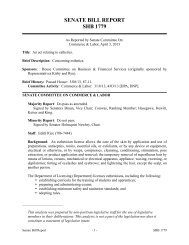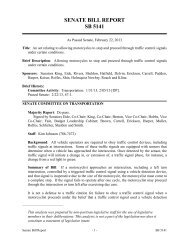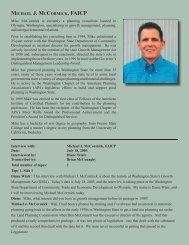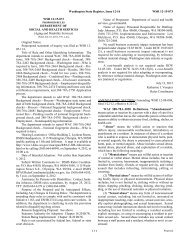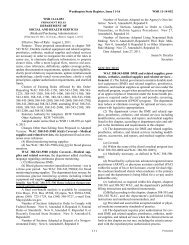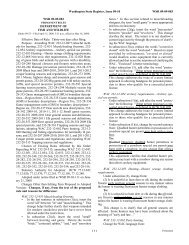Proposed
Proposed
Proposed
You also want an ePaper? Increase the reach of your titles
YUMPU automatically turns print PDFs into web optimized ePapers that Google loves.
(B) The work performed is ahead of the secondary side<br />
of the customer's transformer(s) which supplies power at the<br />
customer's utilization voltage.<br />
If the utility does not directly perform the installation or<br />
work, it may only contract the work to an appropriately<br />
licensed electrical contractor(s). See RCW 19.28.091(3).<br />
This work is considered to be utility type work.<br />
The owner will provide the electrical work permit and be<br />
responsible for requesting inspections and for ensuring the<br />
work is installed per chapter 19.28 RCW and this chapter.<br />
Exemptions - Electrical utility telecommunications transition<br />
equipment installations, maintenance and repair.<br />
(18) No license, inspection or other permit will be<br />
required by the department of any electric utility or, of any<br />
person, firm, partnership or corporation or other entity<br />
employed or retained by an electric utility or its contractor,<br />
because of work in connection with the installation, maintenance,<br />
or repair of telecommunications transition equipment<br />
located ahead of the utility's telecommunications network<br />
demarcation point on the outside of a building or other structure<br />
when the work is performed by a qualified person consistent<br />
with the requirements of the National Electric Code<br />
(NEC) except as provided in (a) and (b) of this subsection:<br />
(a) The following exceptions to the NEC ((shall)) will be<br />
permitted:<br />
(i) An additional service disconnect supplying power to<br />
the transition equipment can be connected on the supply side<br />
of the main service disconnect supplying general power to<br />
the building;<br />
(ii) Service entrance disconnects may be separated when<br />
clearly labeled;<br />
(iii) The service disconnect used for supplying power to<br />
the transition equipment must be connected to the grounding<br />
electrode system using:<br />
(A) # 8 AWG copper or larger grounding electrode conductor<br />
if protected from physical damage; or<br />
(B) # 6 AWG copper or larger grounding electrode conductor<br />
if not protected from physical damage;<br />
(iv) Use of equipment or materials that have been<br />
listed/field evaluated by a recognized independent testing<br />
laboratory or the department;<br />
(v) Low-voltage circuits do not require a separate disconnecting<br />
means and may be grounded to the transition<br />
equipment grounding system;<br />
(vi) Any other variance to the NEC must be approved by<br />
the department.<br />
(b) A variance recommended by a joint utility standards<br />
group composed of representatives of both public and private<br />
utilities or certified by a professional engineer will be<br />
approved by the department unless the recommendation is<br />
inconsistent with meeting equivalent objectives for public<br />
safety.<br />
(c) For the purposes of this section, a qualified worker is<br />
employed by a utility or its contractor and is familiar with the<br />
construction or operation of such lines and/or equipment that<br />
concerns his/her position and who is proficient with respect<br />
to the safety hazards connected therewith, or, one who has<br />
passed a journey status examination for the particular branch<br />
of the electrical trades with which he/she may be connected<br />
Washington State Register, Issue 12-21 WSR 12-21-103<br />
or is in a recognized training or apprenticeship course and is<br />
supervised by a journey level person.<br />
(d) Although the utility is responsible for inspection and<br />
approval of the installation, including the selection of material<br />
and equipment, the department reserves the right to audit<br />
worker qualifications and inspect such installations semiannually<br />
for conformance with the requirements of (a), (b) and<br />
(c) of this subsection but ((shall)) will not collect a permit fee<br />
for such inspection or audit.<br />
(e) If a utility fails to meet the requirements of this section,<br />
the department may require the utility to develop and<br />
submit a remedial action plan and schedule to attain compliance<br />
with this section which may be enforced by the department.<br />
(f) This exemption ((shall)) will be in addition to any<br />
other exemption provided in chapter 19.28 RCW, this chapter<br />
or other applicable law.<br />
Exemptions - Independent electrical power production<br />
equipment exemption.<br />
(19) An independent electrical power production entity<br />
is not required to have an electrical contractor's license to<br />
work on electrical equipment used to produce or transmit<br />
electrical power if:<br />
(a) The entity is:<br />
(i) The owner or operator of the generating facility is<br />
regulated by the Federal Energy Regulatory Commission<br />
(FERC);<br />
(ii) A municipal utility, or other form of governmental<br />
electric utility, or by an electrical cooperative or mutual corporation;<br />
or<br />
(iii) The owner or operator of the generating facility is an<br />
independent electrical power producer and the facility generates<br />
electrical power only for sale to one or more:<br />
(A) Electrical utilities regulated by FERC, municipal<br />
utility, or other form of governmental utility, or to an electric<br />
cooperative or mutual corporation; and<br />
(B) The electrical power generated by the facility is not<br />
used for self-generation or any other on- or offsite function<br />
other than sale to one or more utilities regulated by FERC or<br />
by one or more state public utilities commissions, or to a<br />
PUD, municipal utility, or other form of governmental electric<br />
utility, or to an electric cooperative or mutual corporation.<br />
(b) The entity must supply the chief electrical inspector a<br />
valid master business license issued by the department of<br />
licensing, state of Washington so that the entity's status as a<br />
revenue generating business can be confirmed.<br />
(c) The entity has entered into an agreement to sell electricity<br />
to a utility or to a third party; and<br />
(d) The electrical equipment is used to transmit electricity<br />
from the terminals of an electrical generating unit located<br />
on premises to the point of interconnection with a utility system.<br />
(e) The electrical power production facility's generation<br />
capacity exceeds ((115)) 100 KVA.<br />
(f) Notwithstanding that a generating facility may be<br />
granted an exemption pursuant to this section, the facility will<br />
be subject to all the requirements of chapter 19.28 RCW if the<br />
facility at any time in the future ceases to comply with the<br />
[ 75 ] <strong>Proposed</strong>



